| Home>Myth>Article |
The Little Goddess OtogoSahime
The following text is a slightly modified machine translation and may have some unnatural parts.
==Introduction==
The Sahime legend is a legend that has been widely handed down in the Iwami region, starting from Masuda City, Shimane Prefecture. The name of Sahime is originally derived from Mt. Sahime, the old name of Mt. Sanbe, but in this legend it is a story as a little goddess .
It is a kind of corpse metaplasia type tale, and was established by incorporating the place name tale around Mt. Hirefuru (Mt. Gongen) in Masuda City.
It should be noted that the legend is divided into the first stage when Sahime comes to Masuda and the second stage where Sahime leaves Masuda and reaches Mt. Sanbe. A sad tone story and a bright tone story coexist in an indistinct combination. From this difference in tone, it is possible that the first and second stages were written by different authors. It also points out that the Sahime legend is not found in old literature and is considered to have been established in a relatively new era because it is recognized that the influence of Kiki mythology is strong.
Temporarily, the first stage will be titled "Chibihime-san" and the second stage will be titled "Sahime and Giants". Let's start with the first stage.
=="Chibihime-san" Synopsis==
OtogoSahime is the youngest child of Ogetsuhime. Her body is small enough to fit in a palm. OtogoSahime means the youngest little princess (hime means a princess). Her mother goddess Ogetsuhime was able to produce foods from every part of her body. Knowing this, the savage god who lives in Soshimori (the old place name of Silla) wondered what the structure of the goddess's body was, and slashed Ogetsuhime. But there was nothing. Ogetsuhime, who is breathless, said to Sahime, "It is a regret to leave you young. I will give you the treasure that will never run out for a thousand or a million years." She died. Then, five-grain seeds grew from the corpse of Ogetsuhime. Sahime took the seeds and rode on the back of her red goose, crossing the sea and heading for the eastern country. On the way, the tired red goose went down to the present Takashima-island and tried to rest. Then the hawk, the messenger of Oyamatsumi, stopped. The hawk chased away the Sahimes, saying, "I don't need five-grain seeds because I eat meat." That is why grains still do not grow on Takashima-island. Next, red goose tried to rest on Oshima-island in Sutsu. However, here too, the eagle, the messenger of Oyamatsumi, drove them away. Sahime and red goose took a rest at Kameshima-island (Kame means turtle) in Kamate and landed on Mt. Tento in Akagari-town. From there she proceeded to Mt. Hirefuru, where Sahime opened a seed village around there and she introduced the five-grain seeds to Japan. People called Sahime "Chibihime-san" and got to know her ...
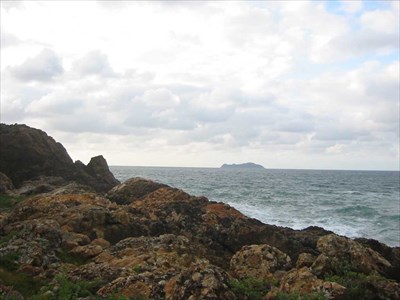
Takashima-Island facing from the Karaoto coast
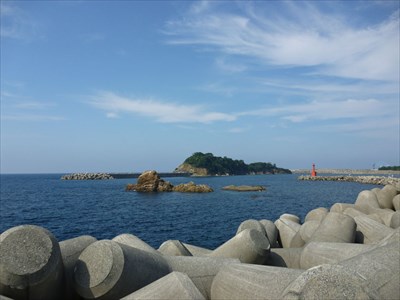
Sutsu Oshima-Island. There is a thermal power plant nearby.
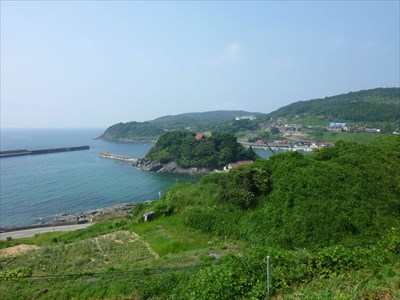
Kamate Kameshima-Island

Akagari Mount-Tento
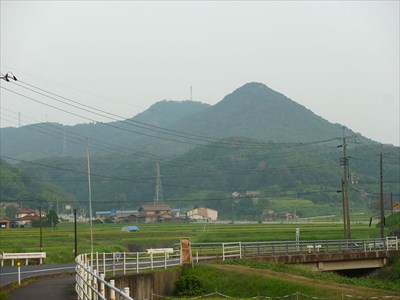
The one with the antenna is Mount-Hilleful
Depending on the narrative, there are three seeds that have arisen, one of the three will be left in the hometown, one of the three will be given to the goose, and one of the other three will be taken by myself. There is also a story that horses and silk moths were born as well as seeds. This is probably derived from the description of Ukemochi no Kami in the Nihon Shoki. However, if it is a silk moth, Sahime can bring it, but it is difficult to carry a horse. Depending on the point of view, it may be considered that it is in a stage where it has not been sufficiently elaborated.
==Legendary analysis==
If you plot it on the map, Sahime will fly from Silla's Soshimori to Takashima-island off the Sea of Japan, Sutsu's Oshima-island, Kamate's Kameshima-island, Akagari-town Mt. Tento, Mt. Hirefuru and zigzag.
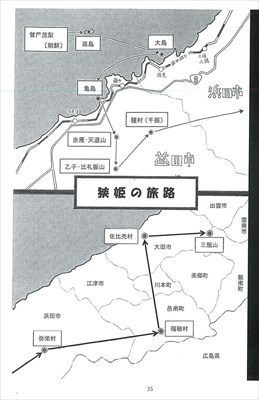
Sahime's Journey
Also, in this story, you can see the motif that Sahime, who has landed on an incorrect land, is repeatedly refused and finally reaches the correct destination.
Ogetsuhime is a goddess who appears in Kojiki and entertained Susanoo who was exiled from Takamagahara, but Susanoo who looked into the place where the Ogetsuhime took out foods from the hole in the body said that it was dirty and killed Ogetsuhime. is. Then, five-grain seeds sprouted from her corpse, and Susanoo presented it to Takamagahara.
In addition, a place name called Soshimori appears, which is a place name that appears in the Nihon Shoki, and Susanoo, who came down to Soshimori, came to Japan saying, "I don't want to be here."
In other words, the rough god that appears in the synopsis implies Susanoo. Therefore, this rough god will not be punished. Susanoo who crossed Izumo defeated Yamata-no-Orochi there and became a hero.
The sprout of five-grain seeds from the corpse of Ogetsuhime is called corpse-type myth, and is classified as Hainuwele-type myth in mythology. It is the origin of grain.
It is also said that Takashima-island, where refused to land Sahime, still does not produce grain.
The motif of a god descending on a bird can be seen in the biography of Monobe Shrine in Oda City and Kanayago Shrine in Yasugi City. These folklore may also have influenced the Sahime legend.
==Who is Sahime==
The first appearance in the literature of "Sahime" is the national myth of Izumo Fudoki, and the phrase "Sahime-yama" appears. Mt. Sahime is the old name of Mt. Sanbe in Oda City, Shimane Prefecture. It is a myth that the god who lamented "Izumo is narrow" staked Mt. Sahime and Mt. Daisen, hanged a rope, pulls the land from Silla and Koshi (Hokuriku), and the present Shimane Peninsula was created.

Mount-Sanbe
During the Jomon period, the sediment that overflowed from the eruption of Mt. Sanbe accumulated through the Kando River system, forming the Izumo Plain. In other words, it is a very old myth.
Therefore, there is a theory that Sahime is the queen goddess of Okuninushi, the king of Izumo.
Sahime can be segmented as either "Sa + Hime" or "Sahi + Me". "Sa" is a prefix for rice such as Saotome Sa or Sanbai Sa, the god of rice fields. "Sahi" means something sharp. "Hime" means a princess and "me" means a woman. Therefore, Sahime can be interpreted as an ambiguous goddess of farming and steelmaking.
==Place name tale==
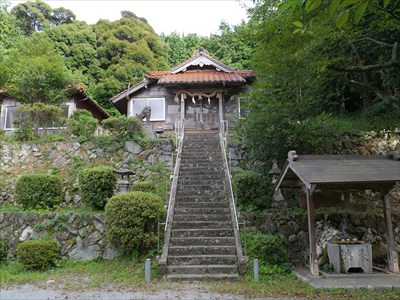
Sahimeyama Shrine
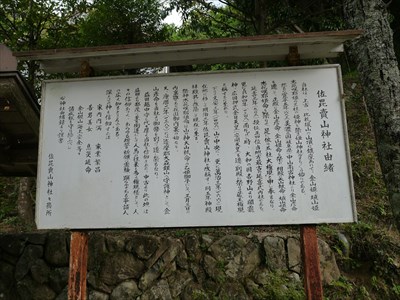
History of Sahimeyama Shrine
There was also one aspect of the Sahime legend that it was a tale of place names around Masuda City. As you have already seen, you can see place names such as Takashima-island, Oshima-island in Sutsu, Kameshima-island in Kamate, Mt. Tento in Akagari-town, and Mt. Hirefuru.
The Edo period geography book "Iwami Yae mugura" also contains the legend of the Iwami region, but does not include the legend of Sahime. Instead, it contains some narratives that seem to have become the prototype of the Sahime legend.
In Otogo's article, there are the following place name tales,
* Konohana-sakuya-hime, the deity of Sahimeyama Shrine, is the youngest child (Otogo) of Oyamatsumi.
* Because there were separated at the end
* Because the elders had separated for the youngest child (Otogo)
In Tane-Village's article, there are the following place name tales,
* Tane-village because there received the seed of rice from the great god who created under the heavens (Okuninushi).
Tane means seed.
In Akagari Article, there are the following place name tales,
* There was an old goose that was aged or a god.
Aka means red and Kari means goose.
==When the legend was established==
In other words, it can be said that the legend of Sahime as a little goddess was born by incorporating these place name tales and writing Sahime with "狭姫".
Since the name of Sahime is derived from Mt. Sahime, it seems to be an old legend at first glance, but the legend is not recorded in "Iwami Yae Mugura", and the place name tale that became the prototype is recorded. From this, it is presumed that the Sahime legend was established after 1817, when "Iwami Yae Mugura" was established.
You may be wondering if I can affirm with just "Iwami Yae Mugura", but "Iwami Yae Mugura" contains the legend of Tagorihime of Hashi and the legend of Yairoishi (although it will be dealt with on another page).
Also, because of the influence of Kiki mythology, the author can profile a person who is familiar with National Studies (Kokugaku) and has a good geography around Masuda. To explain this background, it can be said that National Studies flourished in the Iwami region during the Edo period. Kojiki is rediscovered by the prosperity of National Studies. And Ogetsuhime is a goddess who appears in Kojiki.
Kumaichiro Yatomi, a local historian of Masuda City, considers in "Masuda City Magazine" that the establishment of the Sahime legend dates back to the Middle Ages in connection with the migration of the ancient Kushiro tribe to the western part of the Iwami region. However, the legend of Sahime is not found in old literature. In the Showa era, it can only be traced back to Shutaro Oga's "Honor of the Hometown" quoted in the travelogue "Sekityu Yuki (Travelogue of central Iwami region)" by Mine Horibushi, which was recorded in a magazine called Shimane Criticism.
In terms of the year of publication, bansui Kimura's "Essay Iwami Monogatari" is a little older, but only a part of "Sahime and Giant" is quoted. Therefore, the "honor of the hometown" recorded in its entirety is the oldest.
It is also worth noting that the legend of Sahime is recorded in "History of Naka-county", but not in "Naka-county magazine". "Naka-county magazine" was published in 1916, and "History of Naka-county" was published in 1970. Ikutaro Oshima died in 1949, so it was written by then. Since the Shimane criticism Sekityu issue, in which "Honor of the Hometown" was reprinted, was published in 1936, the establishment of "Sahime and Giant" may be surprisingly new.
==Legendary reality==
At Kushiro-kahime Shrine in Masuda City, there is a tradition that the ancient Kushiro tribe landed from Ohama-beach in Kamate. These tradition may also add reality to the Sahime legend.
According to the legend of Sahime, Sahime and red goose took a rest at Kameshima-Island in Kamate. It's a casual depiction, but it's an element that shouldn't be removed.
Next, let's go to the latter part, "Sahime and Giants." In the process of spreading the Sahime legend, a new legend is born in the area from Misumi-town, Hamada City to Asari-town, Gotsu City.
=="Sahime and Giants" Synopsis==
Sahime came across a giant reminiscent of Daidarabotchi. The giant named Oyamatsumi is not malicious, but every time he moves around, he makes a big fuss. Sahime also escaped, but she can't help because of her small body. She barely escaped alive, but one day she called out to a giant sleeping in a big hole. The giant was a child of Oyamatsumi and was named "Okami" ("Okami" is a dragon god who took in the place name of Okami). Sahime jibbed at the Okami's arrogant attitude, but when she offers a strong attitude that she wants to see him in person, he said, "I am a person with only a head and a body like a snake, so both people and gods will be surprised and faint. It's bad to surprise people, so it's better for each other not to see them, "said the"Okami"suddenly. The "Okami" told her to meet his brother "Ashinazuchi (long-legged)". He is also a giant and can be inadvertently trampled.
Sahime thought that this would not make a peaceful country. One day, Sahime met a female giant named "Tenazuchi(long-arms)" on the Asari coast. When Sahime asked Tenazuchi if she had a husband, she replied, "I have such a long arms." Tenazuchi was ashamed of her long arms, but Sahime comforted Tenazuchi, saying, "I'm extraordinary titch, but I have a duty to spread the seeds. You have your duty." Sahime flew around on a red goose, wondering if there is any good land. Sahime decided to let the giants live in a large area at the foot of Mt. Sanbe, with the Ashinazuchi and Tenazuchi. It is said that the Ashinazuchi and Tenazuchi helped each other and lived in harmony.
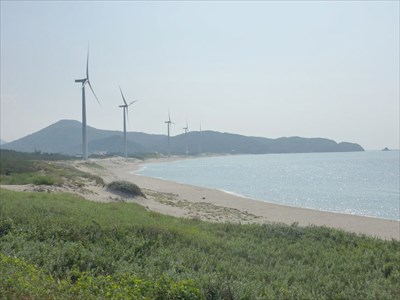
Mount Asari Fuji and Asari Coast
Although omitted in the Synopsis, the identifying himself of the Okami represents the circulation of water in the atmosphere. Okami makes it rain.
The contrast between the little Sahime and the giants is well depicted.
Should we interpret the fact that Sahime has barely escaped the difficulty as a red goose flying and saving when the giant steps on it?
==Giant legend==
The legend of giants was originally independent of the legend of Sahime. There is a tradition that giant dung became a mountain in Mt. Noyama (Mt. Oguso) in Misumi-town, Hamada City. In addition, at Mt. Asari Fuji (Mt. Dobin) in Gotsu City, there is a tradition that when a giant straddles, the testicles hit and the summit was lacked. Misumi-town is an area where tatara iron making is popular, and until the Taisho era, tatara iron making was done. The traces of tatara look like the footprints of a giant. There is also a tradition of the footprints of little people.
As a prototype of the story of Ashinazuchi and Tenazuchi, there is the legend of Ashinaga(Long-legged) and Tenaga(long arms) related to Mt. Bandai in Fukushima Prefecture (which is badly contained by Kobo Daishi). Also, in the tradition of Ashinaga-bito and Tenaga-bito that appears in "Kasshi Yawa", the long-legged person carries the long arms person on his back. It is also said to be a precursor to changes in the weather.
Since the names of the giants are read as Ashinazuchi and Tenazuchi, it can be seen that they are related to the older man Ashinazuchi and the older woman Tenazuchi that appear in the Yamata-no-Orochi myth. It appeals that it is older than the Yamata-no-Orochi myth. It can be said that the author of "Sahime and Giants" was conscious of creating his own myth against Izumo.
The Okami is a dragon god. There is a description in Okami's article of "Iwami Yae Mugura" that Hachiman Shrine originally enshrined the Okami god.
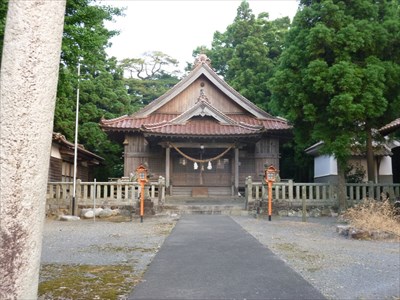
Okami Hachimangu Shrine
As Ashinazuchi and Tenazuchi became a married couple, and when Ashinazuchi carried Tenazuchi on his back, it was close to a distant place, the deep water was shallow, and it was no longer difficult to pick up or work. Gender assistance is said to be the beginning of a couple having a family.
The Okami was later replaced by the god of Hachiman and is no longer in Okami, but before the storm, he still rings a large rock to inform storm. and It is testament that he will never forget his hometown.
==Inconsistency with history==
"Sahime and Giants" is a story about leaving Masuda City and heading for Mt. Sanbe, Oda City. In other words, it is a story of developing the Iwami region from the west to the east. Actually, it seems that it was cultivated from Oda City, which is close to Izumo. Many Iwami Country Shikinai Shrines (the old and officially certified shrines) are also distributed in Oda City.
Also, regarding the tale of the origin of grain in the previous section, rice cultivation is said to have spread via the Korean Peninsula in the Sahime legend, but that is an old theory. Nowadays, it is a strong theory to think that rice cultivation spread directly from the Yangtze River basin in China to Japan.
==Difference in tone of story==
The first stage, "Chibihime-san," takes the form of a corpse metaplasia narrative. In the first part, Sahime continues to be rejected to get off at the wrong place and finally arrives in the mainland of Japan. This is a story with a sad atmosphere. The wicked god that appeared at the beginning will not be punished. That's because Susanoo is the model.
On the other hand, in the latter part of "Sahime and Giants", the story will be a bright tone. The story is a giant tale. The fact that the giant's fart was the eruption of Mt. Sanbe makes us feel the intention to make the listening children laugh. In the latter part, it is a positive story that the grown-up Sahime reaches Mt. Sanbe and cultivates the foot of Mt.Sanbe to make the giant live.
Many folktale books contain only the first part "Chibihime-san". There are few books that contain the latter part, "Sahime and Giants." While showing the existence of the latter part in Masuda City Magazine, the explanation is limited to the first part. In one book, "Sahime and the Giants" is described as an "innocent myth." This is because the sad corpse metaplasia myth and the bright giant tale are mismatching. If you treat them as one, you will get a mysterious feeling that sad story and bright story are mixed together.
From the difference in tone between the two, it is assumed that the story of the first and second stages will be made by another author.
However, if you read Shutaro Oga's "Honor of the Hometown", which dates back to the oldest in the legend of Sahime, both the first and second stories are already recorded there. The book review for "Honor of the Hometown" is "piquant myth."
I reread "Chibihime and Giant" recorded in "Honor of the Hometown", but the body of Ogetsuhime produces not only five-grain seeds but also horses and silk moths. However, the silk moth aside, the horse cannot be carried by Sahime. It is a part that looks like a copy of the description of Nihon Shoki as it is. It's a lack of elaboration, so to speak. Then questions arise. Perhaps this "Chibihime and giant" was in the early stages of the legend. Then, the interpretation of the Sahime legend as a two-part structure may be rather wrong. Am I thinking too much? Anyway, interpreting it as a two-part structure should contribute to the understanding of the work.
There is also a story that Sahime put seeds in her vagina and carried it. If Sahime is an adult, that is not impossible, but she is young. This description may also be at the stage where the story is not completed.
The legend of Sahime has a story that includes yin and yang. Isn't this difficult to configure? It can be said that the connection between motifs is difficult.
==Modern Sahime==
At the foot of Mt. Sanbe, there is a natural museum called Sahimel. This is a coined word consisting of Sahime and email from Mt. Sahime.
There is a schoolchild song called "Hello! This Town" (screenplay / lyrics: Mari Sato, composition: Etsuo Kawasaki), set at the foot of Mt. Sanbe as Sahime's village.
A picture book called "The Great Work of Sakura Sahime" (Taruhi Furuta / text, Iwao Fukuda / picture) has also been published. This is a unfoldment reminiscent of the Kiki Kuniyuzuri myth (Transfer of National control), but it is a story of cooperating with giants to drive the aggressor away.
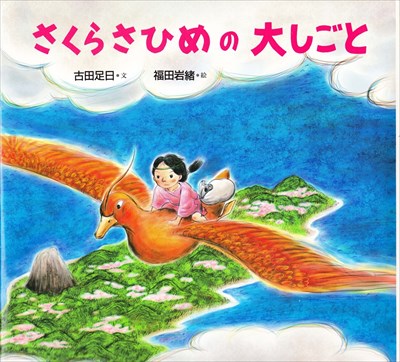
The Great Work of Sakura Sahime
In addition, the legend of Sahime has been made into a manga by local volunteers. It is also in the National Diet Library under the title "The authentic Legend of Sahime". The story is a cartoon version of the contents of the previous section, and it is the story of reaching Mt. Sanbe at the end. It would be fortunate to have someone in their area who could draw manga. It is also sold at Sahimeyama Shrine. The price is 600 yen per book.

The Authentic Legend of Sahime
==Sodeme Nukatabe==
If you deviate from National route No. 9 and head south toward Akagari town, you will find the remains of the mansion of Sodeme Nukatabe in Kibe Myojinbara on the way. The name is recorded in "Shoku Nihongi" as a chaste woman who pioneered Kibe. From this, it can be seen that Nakutabe's clan was also in the Iwami region.
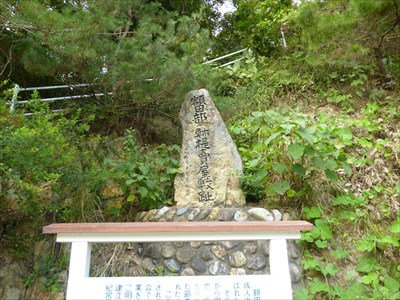
A stone monument at the site of the mansion of Sodeme Nakutabe
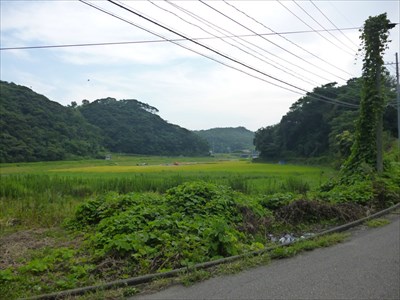
Kibe Myojinbara
After she divorced her husband from the doctor, she allegedly pioneered the Kibe and served the welfare of poor farmers and the sick without remarriage. The era is still under the Handenshuju system, but I wonder if it didn't suit the actual situation in Japan. It is also meaningful as a land where you know who has cultivated it.
Although it is not directly related to the Sahime legend, it is close to Akagari town and may have influenced the establishment of the Sahime legend.
==Digression==
I met the legend of Sahime when I returned to my parent's house in the summer of 2006 and realized that the "Legend of Shimane"(Nihon Hyojun published) was left behind. "Legend of Shimane" was bought as an elementary school assignment book, and contains many legends of Shimane prefecture. The dark and unique style was memorable.
When I returned home on New Year's Day 2007, I rented a car and visited Sahimeyama Shrine in Masuda City. However, the legend of Sahime was not mentioned in the historical signboard. I wondered why this was the reason for my investigation. Sahimeyama Shrine is close to the Tsumo Copper Mine and has KanayamaHiko and KanayamaHime as its main deities. It was also written that KonohanaSakuyaHime and HaniyasuHime were also deities, and SakuyaHime was the youngest child (Otogo) of Yamatsumi.
Sahimeyama Shrine and the legend of Sahime are certainly related, and the legend of Sahime is posted on the shrine's website. In the Story of the shrine, Susanoo kills Ogetsuhime.
I went to the Masuda City Library, went to the local materials corner, and read "Masuda City Magazine" and "Iwami Yae Mugura", and I took it well. The legend of Sahime is a story that was made after the establishment of "Iwami Yae Mugura". I was fortunate that "Iwami Yae Mugura" was printed by the Shimane Prefectural Library.
"Sahime and Giants" was recorded in "History of Gotsu City" edited by Kumataro Yamamoto. Kumataro Yamamoto A geographer who was active before the war.
After that, I drove to a land related to the legend of Sahime. The results are shown in the photos. Akagari Village / interactional Center is a landmark of Mt. Tento. In the Middle Ages, it was said to have been the fort of Masuda clan, who ruled Akagari Village.
There is also Sahimeyama Shrine at the foot of Mt. Sanbe in Oda City, but the relationship with Sahimeyama Shrine in Masuda City is not clear. There seems to be no established theory among researchers. Sahimeyama Shrine in Iwami Ginzan is said to have been solicited by Sahimeyama Shrine in Masuda City. You can see the movement of engineers from Tsumo Copper Mine to Iwami Ginzan.
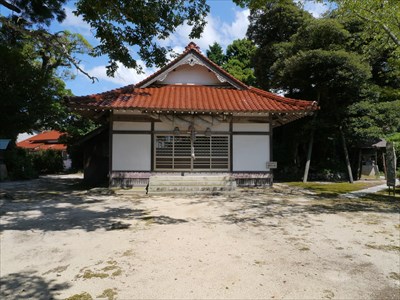
Sahimeyama Shrine at the foot of Mt. Sanbe
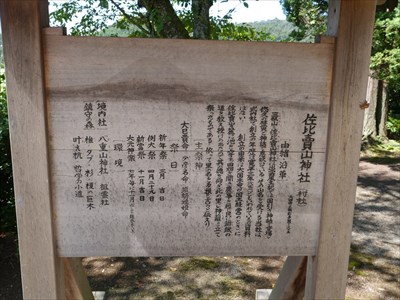
History of Sahimeyama Shrine at the foot of Mt. Sanbe
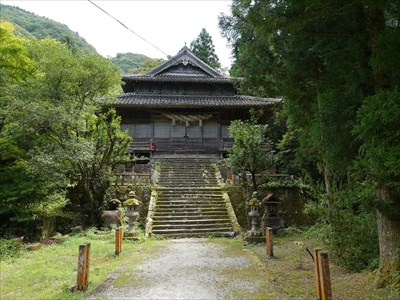
Sahimeyama Shrine in Iwami Ginzan
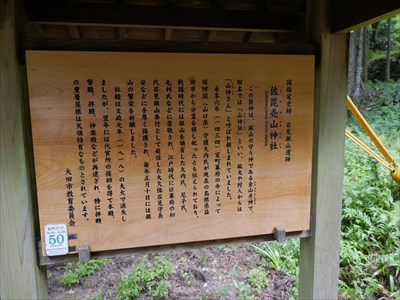
History of Sahimeyama Shrine in Iwami Ginzan
In the "Shikinai Shrines Survey Report Vol. 21, San-in-Do 4", there is a wild grass called Hitosu-Ume (flower similar to Japanese plum) in Mt. Hirefuru in the section of Sahimeyama shrine. It is said to be the flower that Sahime loved, and it has never grown even after transplanting. Isn't there something that Sahime, whose duty is to spread her seeds, can't give up?
"The Wonderful Adventures of Nils" can not be denied that the possibility of affecting the Sahime Legend. "The Wonderful Adventures of Nils" was written as a geographic reading in Swedish country. In addition, "The Wonderful Adventures of Nils" was translated into the Taisho period. Or is it a coincidence?
Sahime also appears in the trading card game. She is "Goddess of Abundant Crops, Otogosahime". There is no doubt because red goose is drawn on the background. It will be said that the characteristic of the Sahime was recognized. I do not understand the rules of the game well, but it seems like a powerful card. June 2020 released. Looking at Twitter, it has a reputation for being "cute".

As mentioned above, the establishment of the Sahime legend may be from a new era. If so, Sahime can be called the youngest child (Otogo) of the gods.
==References==
- *『日本伝説大系 第十一巻 山陰(鳥取・島根)』(野村純一他, みずうみ書房, 1984)pp.17-25
- *『島根評論 第13巻中 第6号(通巻第141号 石中号)』(島根評論社, 1936)pp.77-80
- *『那賀郡史』(大島幾太郎, 大島韓太郎, 1970)pp.113-119
- *『益田市誌 上巻』(益田市誌編纂委員会/編, 1975)pp.356-361
- *『角鄣経石見八重葎』(編集・発行者 石見地方未刊行資料刊行会, 1999)
- *『島根の伝説』(島根県小・中学校国語教育研究会/編, 日本標準, 1981)pp.234-238, p.243
- *『出雲・石見の伝説 日本の伝説48』(酒井董美, 萩坂昇, 角川書店, 1980)pp.246-248
- *『石見の民話 第二集』(大庭良美/編著, 未来社, 1978)pp.97-99
- *『夕陽を招く長者 山陰民話語り部シリーズ1』(民話の会「石見」/編, ハーベスト出版, 2013)pp.138-140
- *『三隅地方の神話と伝説』(寺井実郎/編, 三隅時報社, 1960)pp.13-18
- *『神話・伝説・史跡巡り・人物伝の一端 川平・松川地区および江津市内各地の歴史』(佐々木春季/編著, 1988)
- *『石見鎌手郷土史』(矢冨熊一郎, 1966)
- *『石見高島の秘話』(矢富熊一郎, 益田史談会, 1960)pp.67-74
- *『江津市の歴史』(山本熊太郎/編著, 1970)
- *『三瓶山 歴史と伝説』(石村禎久, 1984)
- *『歴史の落穂拾い 出雲・石見』(石村禎久[勝郎], 石村勝郎, 2000)
- *『随筆 石見物語(復刻版)』(木村晩翠, 白想社, 1993)pp.230-231
- *『伝承怪異譚――語りのなかの妖怪たち(三弥井民俗選書)』(田中瑩一, 三弥井書店, 2010)
- *『畑作の民俗』(白石昭臣, 雄山閣出版, 1988)
- *『さくらさひめの大しごと』(古田足日/文, 福田岩緒/絵, 童心社, 2001)
- *『正史「狭姫伝説」 天地悠久のロマン 益田の神話』(堀江宗仁・田原三千男/編, 乙子観光協会, 2014)
- * 朝山晧「石見國式社考」(二)『神光』第九号 31p. 昭和三十二年
- * 長尾英明『佐比売山神社考―石見の渡来部族と鉱山信仰』「郷土石見」100号 創刊100号記念号(石見郷土研究懇話会, 2016)pp.23-45